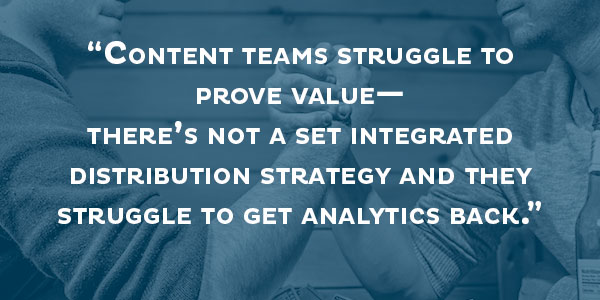Have you documented your 2015 content marketing plan yet? If not, you should.
While only 35% of B2B companies have a documented content strategy, the majority (60%) of those marketers rate themselves highly in terms of content marketing effectiveness, compared to just 32% of those with a verbal strategy.
So, a written plan is key. But it’s not the only important factor.
An integrated marketing strategy requires two things that aren’t guaranteed in that PowerPoint presentation, the one that maps out your yearly plan then sits in a few people’s email inboxes, rarely seen again after it’s presented. It requires:
- Cross-department communication, and
- The flexibility to evolve, either in real-time or through consistent check-ins.
Without these elements built into your process, how will you be able to respond to needs as they arise, either from internal stakeholders or your buyers? How will you even know what needs there are to fill? How will you test different tactics, and figure out how your buyers respond?
Here are 3 ways to implement a transparent and agile enterprise marketing strategy.
1. Establish Feedback Loops

Track what content works and what does not by establishing feedback loops between the content team and the marketing groups responsible for content distribution.
“Content teams struggle to prove value, because there’s not a set integrated distribution strategy and they struggle to get analytics back,” says Riley Gibson, VP of Customer Success, who’s worked with hundreds of Kapost customers to get their content operations in place.
Without hard, quantitative feedback, the content team has no insight into how their work is performing.
But it’s not enough to have intra-marketing alignment. Other teams including sales, services, and support, also need to share their content needs, failures, and successes.
“Why even plan if what you’ve planned isn’t directly related to what the folks who use your content actually need?” Gibson suggests establishing lines of communication between departments, and using the insights from across the organization to evolve and iterate the content marketing strategy to ensure widespread value.
2. Actually Use Your Persona and Buying Stage Research
Targeting specific prospects based on persona and buying stage is an oft-preached best practice, but it quickly falls by the wayside when marketers feel under water. Unfortunately, this neglegence leads to irrelevant and valueless content. Instead of saving time, you’re wasting it on a final product that won’t get any traction.
“If you don’t know who you’re talking to, you won’t be able to create good content,” says Todd Cameron, Strategy Director at Kapost.
“Personas are foundational to content strategy.”
Think of ways to get your team excited about using personas, and to ensure everyone creating content understands your target audience and how to speak to them.
“Get your team excited about creating these personas,” suggest Cameron. “Give each persona a name, pull images, create Fatheads and hang them on the wall. Bring them to life, and they’ll stay top-of-mind.”
3. Evolve Your Personas
Personas, though, are not a one-and-done project. You have to continually refine your understanding of the people you’re trying to reach and how they consume information, particularly as new channels and networks emerge.
“A persona is the amalgamation of current customers or potential customers,” explains Cameron.
Who you’re targeting and how you speak to them must align with the reality of your target audience as they change over time. “Once you have your personas created, check in annually with marketing and sales or a third party resource. Don’t create them in a document that then goes nowhere.”
With these steps, you won’t run the risk of implementing a stale strategy. Instead, you’ll have a living, breathing marketing strategy with input from across the organization and a deeper understanding of your buyers. Make it a more agile, transparent 2015.

